|
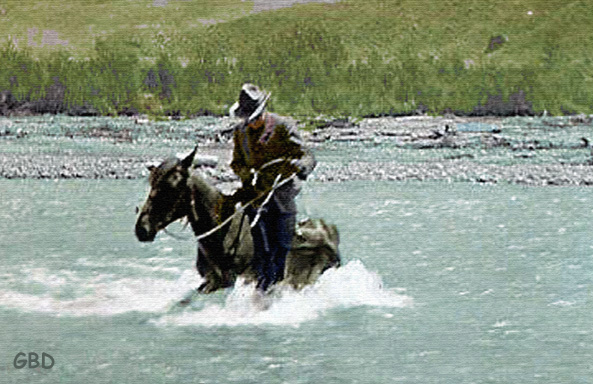
Fording the North Fork Stinking Water above Marquette, approx. 1902. Artwork by G. B. Dobson
When Cody was founded, there was no direct access to Yellowstone Park. What would later be known as the Cody
Road had not yet been laid out. West of Cody behind Cedar Mountain there were a few ranches such as the
Grinder Ranch owned by Edward H. "Ed" Grinder (1869-1946). About 15 miles upstream from Cody was the small town of Marquette.
The town was located on the flats at the confluence of the North and South Forks of the Shoshone then known as
Stinking Water. The town provided a store and post office
serving the area. The flats were sometimes also
referred to as "Poverty Flats."
Access to the area, however,
required fording the river. Marquette was named after early settler George Marquete (1841-1906) who settled in the area in 1881.
Grinder proved up his homestead in 1897.
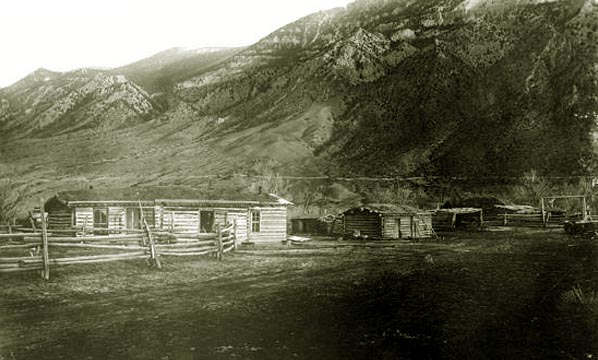
Grinder Ranch, undated, near Marquette. Note the sod roofs on the buildings
Ed Grinder sold the ranch to A. M. Plumb who in turn sold to H. R. Robertson.
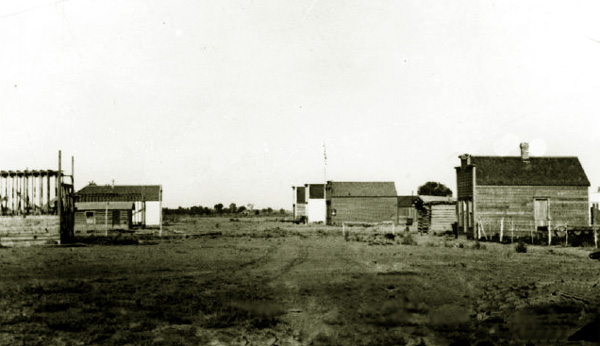
Marquette approx. 1895.
George Marquette established a ranch at what is now
the site of the Buffalo Bill Reservoir. George, known locally as "Uncle George," earlier was a roamer. He served in the Civil War
(Co. "C," 5th Missouri Militia and Co. "H," 11th Minnesota). Following the war, he worked as a tie hack near
Sherman Hill, and later prospected in northern Colorado before coming to Northwestern Wyoming. He acquired some
fame as a fiddle player at local dances and picked up cash as a carpenter.
Uncle George in the 1880's was, in the words of Col. William D. Pickett (1827-1917), the owner an "ornery bench-legged dog."
Col. Pickett (C.S.A.) was a well known railroad engineer,
bear hunter, member of the Boone and Crocket Club, member of the Territorial Legislature,
and is sometimes referred to a the "Father of Big Horn County."
"Bench-Legged," primarily a Southern expression, denotes that the
dog was bowlegged. The dog has been mentioned in at least three different narritives of the early years of
Northwestern Wyoming, Pickett's "Hunting at High Altitudes," Harper & Brothers, 1913; Eanest Thompson Seton's "Wehbi, the Biography of a Grizzly;" and
Richard Patterson's, "Butch Cassidy, A Biography." The dog was responsible in a manner of speaking for the
naming of "Four Bear Creek," near which Col. Pickett established a ranch about 1893. Four Bear Creek is a tributary of
Greybull Creek.
In 1883, Uncle George was employed on Richard Ashworth's
Grey Bull Cattle Company constructing barns and other necessary outbuilding. Ashworth was allegedly a remittance man
from Birmingham. Several years later Ashworth's foreman allegedly took a pot shot at Ashworth but missed, hitting instead a
painting on the wall entitled "The Great Stag.' Ashworth died in 1901 from delirium tremens.
Nearby Otto Franc's Pitchfork Ranch [see
Meeteetse] was engaged in fall roundup preparatory to
the fall shipment to Chicago. At the same time that Uncle George was building the barns, Col. Pickett was
hunting bear along what would later be called Four Bear Creek. Out bounded the dog and stampeded the herd. Most of the herd was trampled to death
in a ravine though which the creek flowed. Pickett realized that the dead
herd would soon attract bears. Soon some appeared. A shot was fired, but missed.
From across the creek came some yelling from a government survey party. The surveyors named the creek "Four Bear Creek." In 1904, Col. Pickett moved to Kentucky,
In 1903, Marquette was described as consisting of a few scattered log houses, a little
log post office and a school-house described as "a little log structure, rude, bare, unattractive, but
occuying a lightly sheltered spot on the South Fork of the Shoshone River."
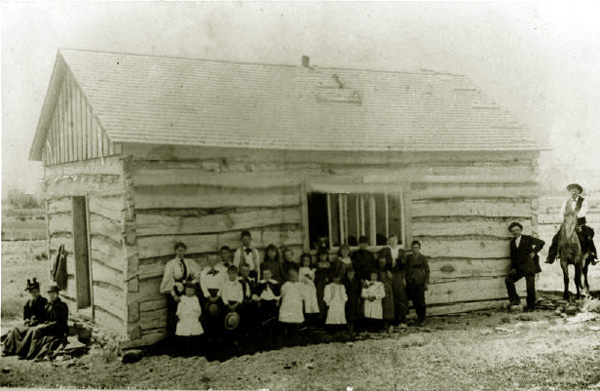
Marquette School, approx 1897.
Slightly downstream from the town was a wire cable structure
stretched from post to post on either side of the river. Suspended from the cable was a small box, attached to
a rope and pully atachments by means of which the occupant of the box could pull himself across the river during
periods of high water.
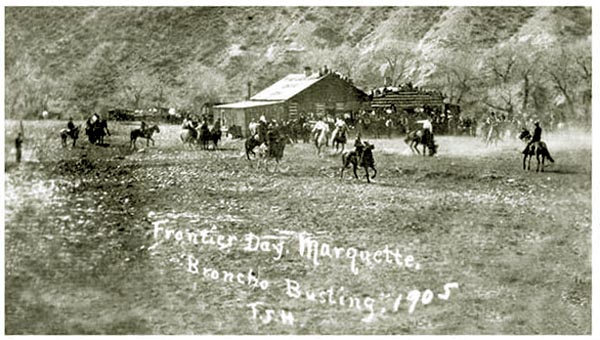
Bronco Busting in front of the McGlashan and McKellar store in Marquette, 1905. Photo by
F. J. Hiscock.
The bronco busting ran for several years about 1905 and 1906. Among those who participated was former
Buffalo Bill's Wild West performer George Gardner, rodeo cowboy Dewey Riddle, Carl Sorenson, and
Ed Grinder's stepson Evan Holman.
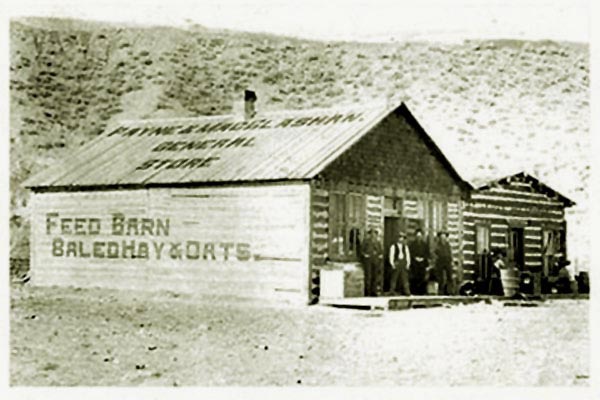
McGlashan and McKellar store in Marquette..
As justice of the peace and acting coronor, Marquette investigated
the killing in 1892 of the horse thief John M. "Jack" Bliss along the South Fork in an
area now known as "Bliss Meadows." Bliss was killed by a former partner in crime, Alfred "Slick" Nard,
reputedly a former member of the Hole-in-the-Wall gang. [Writer's note: Nard' first name is sometimes also
referred to as "Albert."] Slick had such an awful reputation that when he was taken into custody for the
shooting of William Ewing near present-day Slick Creek ["Creek" is pronounced "Crick"],
the deputies sneaked him out of Thermopolis in the dark of the night in order to preclude him
from being freed by the other outlaws. Ed Farlow recalled:
In the morning there was a little excitement when I came over to dress Ewing’s wounds.
Slick and the deputies were gone and no one knew just how. Several of the boys were at the
saloon talking about it. When I rode up they told me Slick had gone.
I said, “Yes, I know it. He should be on the top of Ten Sleep Mountain now on his way to
Buffalo.”
Mike Brown spoke up and asked what was the big idea.
I told him straight. “We did not know how soon you fellows would say ‘turn him loose.'”
Mike replied, “Turn that son of a bitch loose? If you had said the word we would have
helped you hang him. I want you to know this, Farlow. We may rob a bank, or hold up a
stage or a railroad pay car now and then, but we are not killing working men for their
money. We are not that damn low yet.” Farlow, Edward J, Wind River Adventure, High Plains Press, Glendo, 1998.
Nard was married to Jennie Hollywood, sister of Thermopolis saloonist
John "Jack" Hollywood. Hollywood himself was reputed to have killed three men, but convicted
only once, and that for manslaughter of Smith Bray in 1909. Hollywood's defense was three-fold: (a) His shooting of
Bray didn't really kill Bray; Bray died of hypostatic pneumonia caused by a weakened heart brought on by the use
of morphine. (b) Self-defense. (c) Bray had forgiven him. On Bray's deathbed when Bray was "feeling badly," Bray told a nurse,
"It is no use. I am going to die in spite of hell. I want to tell you Jack was not to blame. It was all my fault."
Allegedly, Marquette was unable to find any friends of Bliss along the South Fork, and directed that Bliss
be buried on the spot along the Stinking Water where Bliss fell. Bliss's bones were later swept away in a flood.
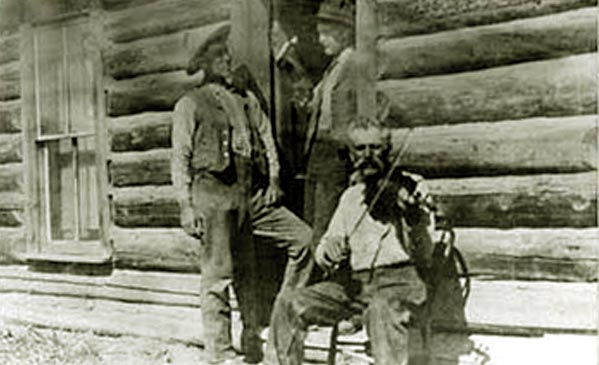
George Marquette (with fiddle).
But the death of Bliss was not the only one with which Marquette was indirctly involved. Marquette was noted for his
ability with a fiddle and would thus play at dances. Dances were a popular entertainment in the 1880's. People would
travel miles to a dance. In the 1880's, the only town around with a hall was Arland located near present day Meeteetse. Arland was not much
of a town, consisting of the obligatory saloon, livery stable, and store operated by the town's founders John F. Corbett (1848-1910) and Victor
Arland. Corbett was originally from Massachusetts and Arland from France. The town also had a hotel or rooming house, the rooms of which were separated by
"walls" made of muslin sheets. Rose Williams operated a sporting parlor. Corbett and Arland had come to the
area about 1880 from Ft. Custer and established a trading post near the foot of Rattlesnake Mountain near present day Cody.
In 1883, the two moved the trading post to Cottonwood Creek.
At Ft. Custer, Corbett had been a freighter and Arland had, apparently, been a buffalo hunter and earlier a miner in the
Black Hills. In 1883, the wagon road from Rawlins to Red Lodge, Montana, had been established by the government and the
businessmen of Red Lodge had raised a public subscription to build a $5,000.00 bridge across the Stinking Water. Thus, the following
year Corbett and Arland moved the trading post once again, apparently to be closer to the action produced by the
twice-a-week stage. Thus, the
town of Arland was born.
In 1887, George Marquette was providing the fiddle music for a dance at the Hall in Arland. On the night in
question, Marquette was tuning up and the dancers pairing up. There appeared in the doorway an
individual variously known as "Broken Nose" Jackson or "Rawhide" Jackson. The music stopped. A hush came over the crowd, that strange
silence which occurs when there is some horrible faux pas. There lying on the doorstep was the dead body of
Jackson and in Victor Arland's hand was a smoking gun. The festivities, however, resumed, with
Vic's remonstrance, "Stop staring like a bunch of idiots. Start up the music, he can't hurt you. He's dead."
Jackson was stowed away in a backroom awaiting burial the next day. And as old-fashioned social columns used to say,
"A good time was had by all." Three years later, Vic Arland and Rose Williams were visiting Red Lodge.
While Vic was playing poker in Dunivan's Saloon, he was killed by a shot through the
window. Rose Williams, herself, was ultimately found dead in the road outside of a house belonging to
Belle Drewry about five miles downstream from Arland.
The music finally stopped in Arland in 1897. At a dance, Belle Drewry plugged
Jesse Conway. Belle was, as they say, "a professional lady" and had arrived in Arland about 1891 from Sundance where
she had run into problems with the law. Conway and Corbett were in a dispute over the affections of Belle. Earlier, others found themselves pushing up daisies as a
result of such disputes. William Gallagher, a Pitchfork cowboy, was killed by
Bill Wheaton after Gallagher beat up Belle. Previously, Belle and Gallagher had been friends. When
Bill was arrested for improperly branding a horse, Belle had gone his bail. A one-eyed cowboy named Bill
Hoolihan attempted to avenge Gallagher's killing. Wheaton was the better shot.
Wheaton was sent off to Laramie for eight years.
After Conway was plugged, his friends loaded his body over the back of
a horse and departed. The next day, however, they returned and killed Belle and three of her
co-workers. By this time, Meeteetse had been founded and probably the main raison d'etre for the continued viability of
Arland were the ladies. With their deaths, Arland faded from existence, the only trace remaining is the
cemetery.
In conjuntion with the development of Cody, Col. Cody and his partner Nate Salsbury planned
a large scale irrigation development. As discussed later, the project contemplated construction of a reservoir across the Shoshone River
slightly downstream from the conjunction of the two forks of the River. Access required construction of a bridge.
In 1902, a used railway bridge was purchased from the Burlington
System and provided the first access to the west side of the river without fording the stream. The bridge would
enable materials to be transported to the dam site and also would promote
tourism to the Town of Cody by providing a second entrace to Yellowstone Park. Prior to the construction of the
Cody Road, access to the park required a trip over the daunting Dead Indian Hill to
Cooke City and then into the park to Mammoth.
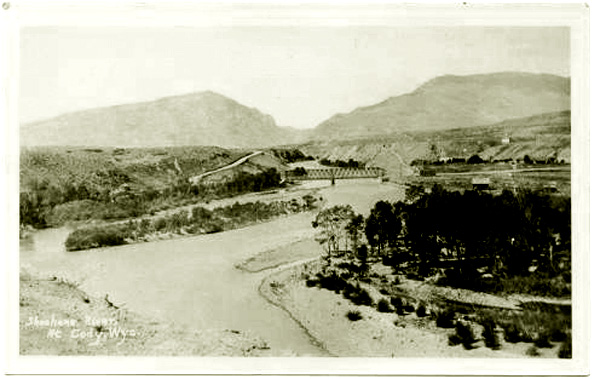
Distant view of Bridge over Shoshone River, undated
Although the new bridge provided access to the west side of the river, it was still necessary to construct a wagon road to
the site of the proposed dam. The Shoshone Canyon lying between Cedar and Rattlesnake Mountains east of Marquette was unsuitable for wagons.
The old trail ran south from Cody and aroung the south
side of Cedar Mountain before crossing the South Fork and then proceeded along the south side of the
Shoshone River. See 15th Report of the Reclamation Service, 1916, pages 489-490. It was not until three years later
that a direct route to Yellowstone was available. The Cody Enterprise, October 20, 1004, reported that
representatives of the passenger department of the
Burlington investigated the roadway from Cody to the Park. They reported that the road from
Marquette west for 12 0r 15 miles was not in proper condition. It was, therefore proposed that that Congress be
requsted to authorized to appropriate funds for the construction of the road.
In 1903, the federal government took over the project of construction of the dam. Construction began about 1906.
As illustrated by comparison of the next three views of the flats upon which Marquette was located.
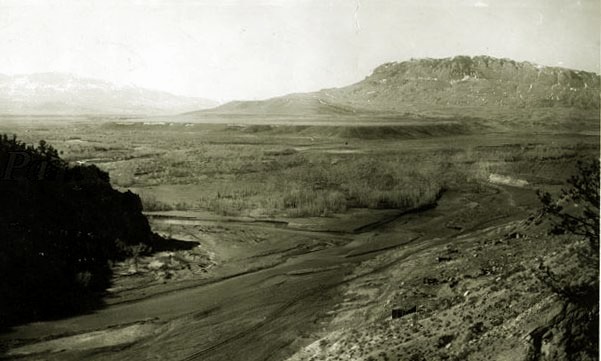
Confluence of North and South Forks Shoshone River, 1906. Photo by
F. J. Hiscock.
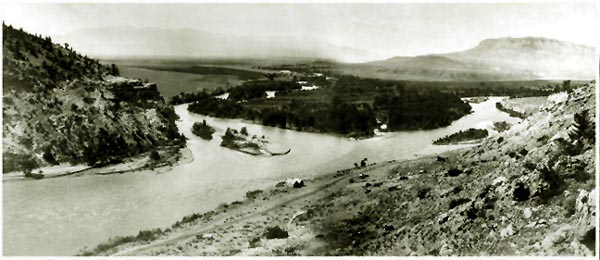
Shoshone Reservoir Spring, 1910
By October, 1910, the area where the little town once stood was completely flooded.
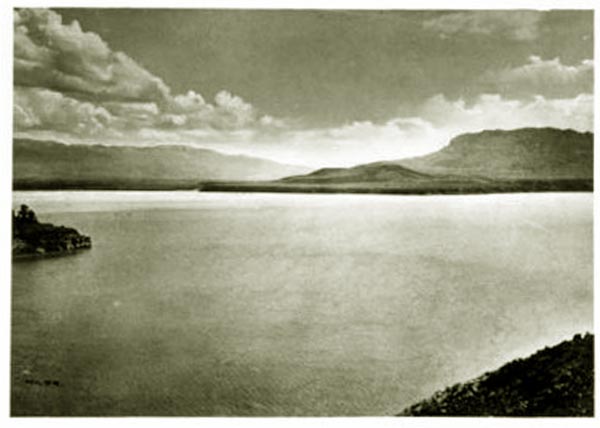
View of Reservoir following completion of the Dam, undated
Uncle George Marquette was the type of person that just about everyone knew, but they knew very little of his background.
In their respective November 29, 1906, editions the Cody Stockgrower and Farmer and the Enterprise reported George Marquette's death.
The Stockgrower and Farmer reported that Marquette died at his ranch from apolexy the previous Sunday. The Enterprise reported that on
the previous Monday, he was engaged in conversation at
the store, gave a slight gasp and fell to the floor dead. The Stockgrower and Farmer reported that
Marquette's funeral was the day before at the Presbyterian Church and that Marquette was born in Findley, Ohio,
"about 68 years ago."
The Enterprise reported that the funeral was at the Episcopal church, and that he was born
about 65 year ago in Germany. Both papers agreed that he was a member of the local camp of the
Modern Woodmen of America who conducted the funeral.
Today, there is even dispute as to where the town of Marquette once stood.
Some of the building were removed to "New Marquette" and others to
Cody. The site of C. P. McGlashan's little general store and Post Office undoubtedly is under the reservoir.
But the name of Marquette lives on in the name of Marquette Creek a small
tributary of the South Fork and its name applied as late as the World War II to the surrounding area along the South Fork where a
new one-room school was constructed.
When the store closed, C. P. McGlashan moved to Cody. In 1911 and 1912, he served as
Deputy Secretary of State in Cheyenne before mmoving to Big Piney where he was a major investor in the
Cretacious Oil Company. In 1917, preparatory to moving to Salt Lake City, he was moving
drilling equipment in the back of his automovile. Thirty miles north of Big Piney on Lander-Big Piney road, a passing
motorist found his body beneath his overturned car.
Next Page: Cody Road Continued, Holm Lodge, Tex Holm, Ned Frost.
|